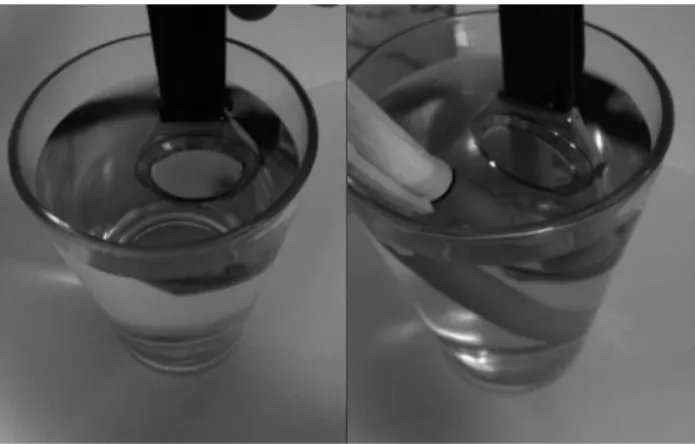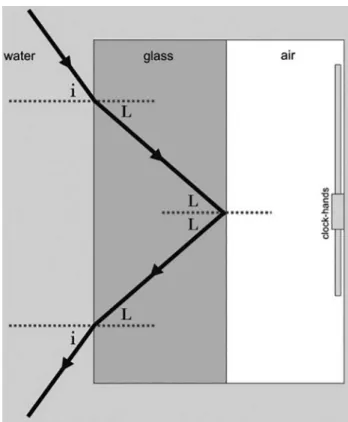Revista Brasileira de Ensino de F´ısica,v. 36, n. 2, 2501 (2014) www.sbfisica.org.br
Desenvolvimento em Ensino de F´ısica
Internal reflection on a watch glass surrounded by water:
A simple experiment and a variation
(Reflex˜ao total em um vidro de rel´ogio mergulhado em ´agua: Um experimento simples e uma varia¸c˜ao)
Jair L´
ucio Prados Ribeiro
1Instituto de F´ısica, Universidade de Bras´ılia, Bras´ılia, DF, Brasil
Recebido em 25/9/2013; Aceito em 7/12/2013; Publicado em 23/5/2014
When a watch is submerged in water, an observer might come to realize that the glass surface appears silver, like a mirror, due to internal reflection. However, it is not possible to clearly identify in which surface - internal or external - this reflection occurs. An experimental variation is proposed, using a thicker glass, allowing better identification of the inner surface as the reflector, along with hints for qualitative and quantitative discussions.
Keywords: refraction, internal reflection, experiment.
Ao mergulhar um rel´ogio na ´agua, um observador pode vir a perceber que a superf´ıcie de vidro aparece prateada, devido `a reflex˜ao total. Entretanto, n˜ao ´e poss´ıvel identificar com clareza em qual superf´ıcie - interna ou externa - ocorre essa reflex˜ao. Uma varia¸c˜ao do experimento ´e proposta, usando um vidro mais grosso, per-mitindo uma melhor identifica¸c˜ao da superf´ıcie interna como a refletora, acompanhada de sugest˜oes qualitativas e quantitativas de discuss˜ao.
Palavras-chave: refra¸c˜ao, reflex˜ao total, experimento.
1. Introduction
A watch display is usually covered by a glass mem-brane, like the ”crown”type (refractive index 1.52) [1], often with great transparency. If the clock is surroun-ded by water (refractive index 1.33), it is not always possible to observe the clock panel: instead, the obser-ver may perceive the glass as a silobser-ver surface, acting like a mirror, thus reflecting the objects immersed in the water around the clock (Fig. 1). This phenomenon can be observed if the line of sight is almost parallel to the glass surface, but the pointers are seen normally in a front sight.
The experiment is quite simple and can be accom-plished in a middle or high school classroom. The ”ex-perimental apparatus”is rudimental (a glass of water and a clock), so the students can bring it to the class-room themselves.
No mention of this experimental activity was found in the reviewed literature in recent years [2-8] or even physics high school textbooks [9-12], despite the ease of obtaining it. Its explanation demands only elemen-tary knowledge about the total reflection phenomenon. The main difficulty lies on demonstrating that internal reflection occurs at the diopter which separates glass from air, and not on the surface between water and
glass. To this end, we designed an experimental varia-tion: a “thick glass watch”, for an easier viewing of the actual position of the reflecting surface.
Figura 1 - Silver surface (left) and reflection of nearby objects (right).
2.
Fast qualitative explanation
Although topics related to total internal reflection are constantly found in the reviewed journals [2-8], the for-mation and observation of a reflecting surface is rare. An exception is the Ref. [7], which shows that a fish
1
E-mail: jairlucio@gmail.com.
2501-2 Ribeiro
sometimes will not be seen inside an aquarium, due to total reflection. Still, this reference fails to mention the ”mirrored”surface, perceived by the external observer. The total reflection occurs in flat or curved diopters, when the incidence angle exceeds the critical one. If two substances have refractive indexesn1andn2> n1, Snell’s law shows that the critical angle (L) is
sinL=n1
n2
. (1)
As glass has a higher refraction index than water, the internal reflection does not occur at the first re-fraction. The mirror effect only happens if light is not refracted from glass to internal air. Thus, the total re-flection must occur in this diopter (Fig. 2), provided that the critical angle is exceeded.2
If the glass thickness is small, the observer will not be able to perceive the inner surface as the reflector. A thicker glass allows a more accurate location of the reflected image. Using a waterproof silicone adhesive, a small (10 x 10 cm) colorless piece of thick glass (1 cm) was attached to a tin cap (Fig. 3), creating a “thick glass watch”. The face of a clock was printed and pas-ted on the inside for a better comparison.
With this device, an experimental variation can be conducted. The “thick glass watch” is submersed in water, while a knife handle touches the glass, allowing the observation of its reflected image (Fig. 3). By doing this, the position of the reflecting surface becomes vi-sible as a gap between the object and its image. This gap would not occur if the reflecting surface was the ex-ternal one: in this case, the object and its image would appear to be touching each other.
3.
Faster quantitative explanation
The refractive index measurement of glass and water is beyond this work scope. Using the available data in Ref. [1], the critical angle of the glass/air diopter is
sinL= n1
n2
→sinL= 1,0
1,52 →L = 41
◦. (2)
Applying Snell’s law, the minimum incidence angle at the separation surface between water and glass is
nA.sini=nB.sinL →1.33 sini=
1.52 sin 41◦ →i = 48◦. (3)
The high value of the incidence angle explains why the viewer must look almost parallel to the glass surface in order to observe the silver (mirror) effect.
Figura 2 - Light path.
Figura 3 - The “thick glass watch” (left) and the gap between the object and its image (right).
4.
Perspectives
The proposed experiment is quite simple – one could even say simplistic. A more detailed experiment setup, like an adaptation of the method proposed in ref. [6] might allow quantitative data measurement of the glass refractive index, or even its thickness.
During the research, another variation was conduc-ted: a laser beam was pointed into the “thick glass watch”, which was submersed in a transparent jar, in order to show the light path, as predicted in fig.2 (some milk drops were mixed into the water, so the scattered light was visible). Unfortunately, the glass piece was 2
Internal reflection on a watch glass surrounded by water: A simple experiment and a variation 2501-3
very transparent and the path didn’t turn out to be visible. An experimental variant could be proposed for this demonstration, using a thick acrylic plate instead of glass.
In an introductory physics course, it is recommen-ded a more phenomenological approach to the refrac-tion and its associated phenomena. In that case, this experimental activity could be included, as it allows the teacher to show in which diopter the total reflec-tion occurs – if quesreflec-tioned, students tend to respond that the reflection occurs between water and glass, and not between glass and air, precisely because of the small thickness of the solid material. Therefore, the descri-bed experiment can become a creative and easy way to present and discuss the light refraction.
Acknowledgments
The author would like to thank Mr. Daniel Nunes, for his valuable work of text revision, improving the gram-mar, style and text cohesion.
References
[1] D. Halliday, R. Resnick and J. Walker, Fundamentals of Physics (John Wiley & Sons, 2011), 9a
ed.
(exten-ded), p. 906.
[2] R. Mendon¸ca, L. Misoguti, R. Muniz, M. Tuboy e V. Bagnato, Revista Brasileira de Ensino de F´ısica20, 496 (1998).
[3] S. Wong and S. Mak, Physics Education43, 198 (2008). [4] B. Viss and A. Sikkema, The Physics Teacher43, 471
(2005).
[5] J. Roeder, The Physics Teacher45, 182 (2007). [6] T. Greenslade, The Physics Teacher45, 420 (2007). [7] Z. Yuhua and S. Fengliang, The Physics Teacher47,
424 (2009).
[8] S. Micklavzina, Physics Education48, 561 (2013). [9] J. Bonjorno, R. Bonjorno, V. Bonjorno, C. Ramos e
L. Alves, F´ısica: Termologia, ´Optica e Ondulat´oria
(FTD, S˜ao Paulo, 2010), v. 2, 1a
ed.
[10] F. Ramalho, N. Ferraro e P. Toledo,Os Fundamentos da F´ısica v. 2 – Termologia, ´Optica e Ondas(Moderna, S˜ao Paulo, 2009), 10a
ed.
[11] M. Pietrocola, A. Pogibin, R. Oliveira e T. Romero,
F´ısica em Contextos: Pessoal, Social e Hist´orico: Energia, Calor, Imagem e Som: Volume 2 (FTD, S˜ao Paulo, 2011), 1a
ed.
[12] I. Anjos,F´ısica para o Ensino M´edio: Volume ´Unico
(IBEP, S˜ao Paulo, 2005), 1a

